 Image search results - "an" Image search results - "an" |
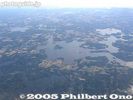
Finland: Land of Lakes 湖だらけの国When you look at a map of Finland or see it from the air, the first thing you notice is that it has a lot of lakes. Ten percent of the country is covered by lakes, but from the air over the southern half, it looks like least 30%-40% of the land is water.
It looked like a field of giant puddles or one giant marshland. It was like the country was sinking into ocean. I had never seen so many lakes in my life. Incredible. And if it's not water, it's forests. Some 70% of Finland is covered by forests.
I think Finland will someday become a popular tourist destination, especially for people who need to escape the urban hustle-bustle and stressful lifestyle. There are nothing like trees and lakes which can pacify humans.
Basic intro to Finland: http://virtual.finland.fi/
Finland map: Virtual Finland map
上空からも直ぐ分かるけど、フィンランドは湖がとっても多い国。20万弱の湖。面積の一割が湖。なんと国の7割は森林。湖と森林は、人を癒すものである。
HP: フィンランド政府観光局(日本語)
|
|

Letter of Thanks from PhilI really enjoyed my first trip to Finland during September 4-18, 2005 (Sept. 8-17 in Kuusamo) and savored every hour. The people in Kuusamo were all so nice and it was a great pleasure to meet and see the work of many talented and dedicated photographers from Europe.
They have definitely piqued my interest and opened my eyes to the nature and wildlife in northern Europe and the Arctic region. I've also become much more keenly aware of the seriousness of global warming. People in Finland have told me how the climate has become noticeably warmer over the decades. Such countries near the polar regions are the first to feel and see the detrimental effects of global warming. I really hope we can someday reverse the trend.
I want to thank the people who made my sponsored trip and participation in Kuusamo Nature Photo 2005 possible and very enjoyable. After months of email correspondence with the festival staff, it was great to finally meet all of them face to face. It makes a big difference when you know the face and person behind the name.
I know they worked very hard to pull off a very successful nature photo festival. For all the email correspondence, coordination, and making all the arrangements, I especially want to thank the following:
Lassi Rautiainen, Kuusamo Nature Photo Director
Pekka Pirhonen, Kuusamo Culture Department Manager
Seija Väisänen
Hannele Pappila
Town of Kuusamo
Corporate sponsors
I also want to personally thank the following people:
Pirkko Väätäinen, my interpreter who interpreted my three slide shows into Finnish.
Hannu Hautala and wife Irma, for having us over at his home/office. Despite his fame, Hannu is a very down-to-earth and warm-hearted man. It was a great pleasure to meet him, to see his collection of Japanese photo books, and hearing about his two trips to Japan.
Barbara, for videotaping my slide shows with my video camera and taking some great snapshots of me enjoying myself in Kuusamo. And also for providing transportation to/from the airport.
Tõnu Ling, for taking snapshots of me in Kuusamo and being my first friend in Kuusamo (we met on the plane to Kuusamo).
Koillis sanomat newspaper and reporter Tuomo Pirttimaa for interviewing me in an article they published.
Again, I have to thank Lassi for everything. He was the one who took care of all the details even during our nature trips. Lending sleeping bags, carrying hot drinks in heavy thermos bottles, driving us all over the place, answering all our questions, taking pictures of us, and making sure everyone had an enjoyable time. He turned out to be quite humorous. I can highly recommend him to anyone who needs a very knowledgeable local guide to watch or photograph wildlife in Finland.
See his Web site: Articmedia
Finally, I want to thank all the people and photographers I met at Kuusamo for their pleasant company and friendship. Remember that you have a friend in Japan. If you ever come and visit, let me know.
Meanwhile, I hope you enjoy this permanent online gallery of Finland photos explained in both English and Japanese.
Philbert Ono
Tokyo, Japan
P.S. In case you don't know, "kiitos" means thank you in Finnish.
|
|
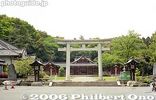
To Kannon-yama
|
|

My video of 2023 Koenji Awa Odori. 第64回高円寺阿波おどり
|
|

My video of 2018 Koenji Awa Odori 第62回高円寺阿波おどり
|
|

My video of 2017 Koenji Awa Odori (56 troupes) 第61回高円寺阿波おどり
|
|

My video of 2016 Koenji Awa Odori (56 troupes) 第60回高円寺阿波おどり 56連の総集編
|
|

My video of Koenji Awa Odori 2015 第59回高円寺阿波おどり 40連の総集編
|
|

My video of Koenji Awa Odori 2013 Part 1/3 第57回 東京高円寺阿波おどり 総集編
|
|

My video of Koenji Awa Odori 2013 Part 2/3 第57回 東京高円寺阿波おどり 総集編
|
|

My video of Koenji Awa Odori 2013 Part 3/3 第57回 東京高円寺阿波おどり 総集編
|
|

My video of Koenji Awa Odori 2011 Part 1/2 高円寺阿波おどり
|
|

My video of Koenji Awa Odori 2011 Part 2/2 高円寺阿波おどり
|
|

My video of Koenji Awa Odori 2009 Part 1/3 - Kokesaku 苔作
|
|

My video of Koenji Awa Odori 2009 Part 2/3 - Kikusui-ren 菊水会菊水連
|
|

My video of Koenji Awa Odori 2009 Part 3/3 - Asuka-ren 飛鳥連
|
|

The Kannon statue peers over the trees.
|
|

Entrance and stairs going up to Shorinzan, a small hill. 少林山
|
|

Held during late April to early May, Kanna's Koinobori festival of carp streamers is this town's claim to fame. About 800 colorful carp streamers swim in the sky above a river. Strings of carp streamers viewable from the road.
|
|
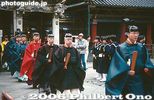
Also called "Sennin Gyoretsu" (1,000-person Procession 千人行列), this is Nikko's largest festival held on May 17-18. The highlight is a long procession of over 1,000 people dressed in various costumes.The three portable shrines are dedicated to the spirits of Tokugawa Ieyasu, Toyotomi Hideyoshi, and Minamoto Yoritomo. Photos start with May 17 at Toshogu Shrine, when priests gathered for a ceremony. 発興祭
|
|
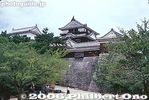
Matsuyama Castle
|
|
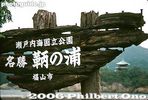
Sign for Tomonoura. Tomonoura is a National Important Traditional Townscape Preservation District (重要伝統的建造物群保存地区).
|
|

Sign for boat going to the islands (no longer in service)
|
|

Okazaki Castle towerThe castle was dismantled during the Meiji Period and the area was made into a castle park. The castle tower was later rebuilt in 1959.
|
|
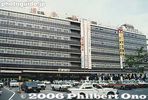
Hakata Station, gateway to Kyushu
|
|

One of the Big Three Festivals in Tohoku, the Kanto Matsuri has men in happi coats balancing tall paper lantern-bedecked bamboo poles, called kanto, on their foreheads, shoulders, hand palms, or hips. Held on Aug. 3 to 6 near JR Akita Station.A kanto is carried to the festival site before nightfall.
|
|

Haneda to Tokushima
|
|

One of Japan's grandest festivals, the Tokushima Awa Odori is a summer dance performed in central Tokushima city. Numerous dance troupes called "ren" appear in a long parade along the city's main streets for four evenings in mid-Aug. About 2 million people see it during the four days it is held. It is like a bon dance to greet the souls of the deceased returning to visit. There are other Awa Odori festivals in Japan, but the one in Tokushima is the original and largest one. "Awa" is the former feudal name of Tokushima. Photo: Entrance to one of the spectator areas called "embujo" (admission charged). 藍場浜演舞場
|
|

Uwajima Castle tower (Important Cultural Property), Ehime Prefecture.
|
|
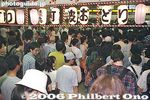
Crowd at JR Koenji Station on Awa Odori night.The Koenji Awa Odori is basically a parade of dancers. Many groups of dancers from various parts of Japan participate in the parade that follows the main shopping streets near Koenji Station on the Japan Railways Chuo Line in Tokyo.
|
|

Occupying a huge plot of land in the center of the city, Kanazawa Castle has undergone extensive renovations and reconstruction. The main castle buildings are now magnificently restored.
|
|

Kenrokuen is one of Japan's three most famous gardens (besides Korakuen in Okayama and Kairakuen in Mito, Ibaraki). The garden was originally the castle garden for Kanazawa Castle. Katsurazaka Entrance to Kenrokuen Garden 桂坂口
|
|

JR Chiba Station and Yokosuka Line
|
|

April 8, 2006 at Ushigome-Tansu Kumin Hall in Kagurazaka, TokyoStarting at 4 pm, this was the third and last show of the day and all 400 seats were sold out.
The performance had two parts separated by a 20-min. intermission. Each part had several different dances.
|
|

Map of Kanazawa Castle Park and Kenrokuen Garden
|
|

Established in 1617, Tsukiji Hongwanji temple is the Tokyo headquarters of the Nishi Hongwanji Jodo Shinshu sect. The present temple, based on Indian architecture, was built in the 1930s.The temple is the only one in Japan which is under the direct control of the sect. Its head priest is the Monshu Abbot himself. April 8 is observed as Buddha's birthday, called Hana Matsuri ("Flower Festival) in Japan.
|
|

One of Kyoto's Big Three Festivals held on May 15. The Aoi Matsuri's colorful procession of over 500 people in Heian-Period costumes start off at the Kyoto Gosho Imperial Palace and head for the Shimogamo and Kamigamo Shrines. Kyoto Gosho Imperial Palace 京都御所: The first ox carriage waits for the procession to start. The ox carriage is called a gissha. 牛車
|
|

Hino was home to many Omi merchants who plied up and down Japan during the Edo Period to sell and trade their wares. They became quite successful selling medicines, lacquerware, sake, etc. Those from Hino were called Hino shonin (Hino merchants).
|
|
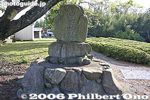
Nakano Castle, also known as Hino Castle, built in 1534 by Lord Gamou Sadahide (1508-1579). In 1582, when Oda Nobunaga was assassinated in Kyoto, Lord Gamo Katahide brought Nobunaga's wife and children from Azuchi Castle to Hino Castle for their safe
|
|
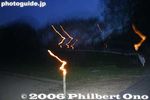
Held annually on May 4, the Misaki Shrine Fire Festival (hi-matsuri) has local people carry 2-meter long torches from their homes to the shrie where a 5-meter tall pile of bamboo is lit to make a towering inferno.A taiko drum is also carried and beaten.
|
|

PR poster for the Kamogawa Odori geisha dance held during May 1-24 in Pontocho.
|
|

Yasukuni Shrine during the Mitama Matsuri before dark.
|
|

Kanagawa Prefecture's largest Awa Odori is held annually during the last weekend in July in this city of Yamato. Preview event near Yamato Station.
|
|

Held for two evenings on Aug. 14-15 during the obon season, people light their torches at Gosha Shrine and proceed to Hibarino park where the torches are thrown up to a large pine tree. The more torches get stuck on the tree, the better the next harvest.This is Hibarino park. The pine tree on the right of the small hill is the target for the torches. This park also serves as the Otabisho during the Hino Festival.
|
|

Sign and entrance to Tokyo Big Sight
|
|

Kanayama Jinja Shrine is a small shrine within the grounds of the Wakamiya Hachimangu Shrine near Kawasaki Daishi Station. On the first Sun. of April, it holds this now-famous Kanamara Festival nicknamed the Phallus or Fertility Festival. Festival starts at 11 am. But a large crowd was already there well before that time. Entrance to shrine on the day of the Kanamara Festival. (If you're below age 18, please leave now.)
|
|

At 2 pm, the 18 portable shrines gather at the Ohara Fishing Port. 大原漁港に参集
|
|

Cherry tree forest near the Nishi-guchi (west) gate.
|
|

The outdoor architectural museum is within Koganei Park in Koganei, Tokyo. This is the Visitors Center.
|
|

Ryogoku Kokugikan sumo arena as seen from Ryogoku Station
|
|

The Kokugikan as seen from JR Ryogoku Station platform.
|
|

Ainokura can be reached by bus from Shirakawa-go in Gifu Prefecture. Some scenery along the way by bus to Ainokura.
|
|

Toyama Castle 富山城
|
|

Monorail to Chiba Koen Station 千葉公園駅
|
|

Chiba Castle as seen from Kencho-mae monorail station.
|
|

Entrance to Honmaru Goten palace, Kawagoe Castle.
|
|

JR Nagano Station festooned with Olympic logos.
|
|
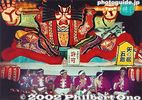
Nebuta are giant, wire-frame, paper lanterns shaped in various legendary and macho characters.The Aomori Nebuta Matsuri is held in Aomori City in Aomori Prefecture during Aug. 2-7. Nebuta are giant, wire-frame, paper lanterns shaped in various legendary and macho characters such as samurai warriors, demons, and gods. They are fantastic works of art dramatically illuminated from the inside. The floats are paraded along the main streets of the city near Aomori Station every night of the festival.
From August 2 to 6, the Nebuta parade is held from 7 p.m. to 9 p.m. On the 2nd and 3rd, the parade is geared for the many children who participate by pulling the floats. About 15 large Nebuta floats and some small Nebuta floats for the children are paraded.
The festival's peak period is from the 4th to the 6th when over 20 large Nebuta floats make their rounds. Be sure to see the festival on one of these three nights.
On the 7th, the last day, the parade is in the afternoon from 1 p.m. to 2:30 p.m. Later in the evening, the Nebuta floats are put on boats to be highlighted by a fireworks display.
The festival is designated by the government as an Important Intangible Folk Culture Asset and not to be missed if you have the chance. It's well worth the trip up north.
|
|

Moving the Neputa floats into position.Held during Aug. 1-7, the Hirosaki Neputa Matsuri is without the rowdiness of the Aomori Nebuta Matsuri. Instead of the haneto, there are many children pulling the floats with ropes. The main floats are fan-shaped and more two-dimensional and lantern-like. As with the Nebuta floats, the Neputa floats are handpainted and illuminated from the inside. There are two parade routes which are followed alternately on different nights. On the 7th, there is only a daytime parade from 10:00 a.m. If it rains on any day, the parade may be canceled.
|
|
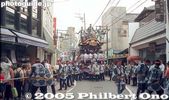
Held in July, Narita Gion Matsuri Festival has ornate floats pulled on the streets of Narita and to Narita-san temple. Pulling a float on the street
|
|

From late April to early May, five long strings of giant carp streamers swim in the air high above the Sagami River in Sagamihara, Kanagawa. This event was started in 1988.
|
|

The biggest taiko drum festival in the Kanto region is held annually in April. Various taiko drum troupes perform for two full days on various outdoor stages in Narita, including the main stage in front of the Narita-san temple.
|
|
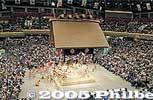
More people than the real tournamentAbout 8,000 people took time out from their Golden Week holidays to see this official sumo practice of all sumo stables.
|
|

JR Kofu Station
|
|

One of two giant kitesThis festival has two giant kites and two smaller (but still large) kites. Resting on its side, the kite was scheduled to fly at 2 pm. The kanji characters read "Michi no Eki" in reference to a new train station built in the town.
|
|

Standing 41.8 meters high, equivalent to a 9-story building.
|
|
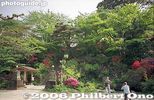
Garden
|
|

Strings of carp streamers latched to the ground from the mountaintop.
|
|

Fukuyama Castle tower
|
|

Ferry between Tomonoura and Sensui island.
|
|
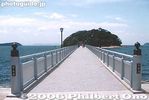
400-meter long bridge to Takeshima island near JR Gamagori Station. The island is made of granite. Circumference is 680 meters. There's a walking path around the island.
|
|

Rabbit Island
|
|

The festival is held along a straight, 800-meter section of San'o Odori Road, a 20-min. walk from Akita Station.In the evening, the main event starts at 6:38 p.m. with a taiko drum-beating performance or minyo dancers on San'o Odori Road. At 7:17 p.m., some 200 kanto are carried into the street to the sound of flutes and taiko drums. At 7:40 p.m. following a brief address by the city's mayor, the performance begins as the kanto are raised all at once.
|
|

Hi Philbert! Welcome aboard!
|
|
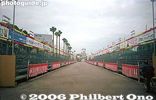
Spectator seats. Admission is 1,000 to 2,000 yen.
|
|
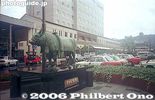
Fighting bull statue in front of Uwajima Station.
|
|

Each dance troupe starts with a lantern bearer showing the name of the troupe.The dance is quite simple. While bobbing up and down, the dancer holds her hands above the head and shakes the fingers. This hand gesture indicates that the person has gone crazy. It is therefore nicknamed the "fool's dance." The dance is held on the last weekend in August.
|
|

Kanazawa Castle was the base for the Kaga Domain (Ishikawa and Toyama Prefectures) ruled by the Maeda clan 1583–1871 starting with Maeda Toshiie.
|
|

Entrance to Inohana Park
|
|

Part 1 - Edo Scenes (江戸風情): 1. Fuji Murasaki (Purple Wisteria) 藤むらさきDancers: 小奴、千佳、由良子、舞子
|
|

Ninomaru Northern Stone wall along a moat. 二の丸北面石垣
|
|

Women at the starting line for triathlon
|
|

Kenrokuen is classified as a "kaiyu-shiki teien" (回遊式庭園) or "circular-strolling Japanese garden." It's a common and classic Japanese garden design where you simply walk around the garden, usually around a central pond.
|
|

Tsukiji Hongwanji temple gate with wisteria crest.The emblem is a wisteria flower and symbol of the Jodo Shinshu sect.
|
|
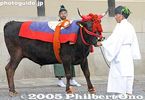
The bull was mooing all the time and was very restless.Do bulls moo or do they snort? This was making a loud noise.
|
|

Barrels of Hino merchant sake
|
|

The castle was abandoned in 1597. Only a few stone walls and shrines remain adjacent to Hinokawa Dam. This is one entrance to Nakano Castle. Map
|
|

Pontocho Kaburenjo theater, venue for Kamogawa Odori.
|
|
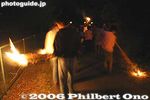
Procession of local residents carrying torches to the shrine. Map
|
|

Kameyama Castle was built by Akechi Mitsuhide in the 16th century as his base for his conquered Tanba region.
|
|
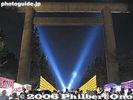
Yasukuni Shrine's main torii during Mitama Matsuri
|
|

Kiso River with Inuyama Castle in the distance
|
|
|
|

Entrance to Gosha Shrine. 五社神社
|
|

Tokyo Big Sight hallway
|
|

Shrine banners and cherries in full bloomThe red banner says "Kanayama Jinja" with an phallus (erect) logo on the top.
|
|
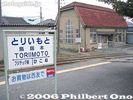
Although the Honjin is long gone, there are a few reminders of its shukuba past. Near Ohmi Railways Toriimoto Station. Map
|
|

They run around while carrying a portable shrine.
|
|

Koganei Park sakura
|
|

Going to visitors center
|
|

Crowd outside the Kokugikan await their favorite wrestlers.
|
|
|

JR Chiba Station platform
|
|

View of Chiba Park from monorail. 綿打池
|
|

Kitain Main hall, Kawagoe
|
|
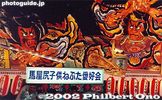
The Nebuta floats are judged in a contest and various awards are given.The Nebuta floats are beautiful objects of light. They are swung left and right and all around. The crowd applaud whenever the Nebuta faces them directly. The sculpture's lights inside are powered by a noisy generator on wheels under the float. The parade progresses quickly and the splendid Nebuta figures pass by one after another. You have to be there in person to feel the power and presence of the giant Nebuta. They represent the very soul and spirit of men. It's enough to give you goose bumps.
The Nebuta floats are judged in a contest and various awards are given. The best ones are preserved at the Nebuta-no-Sato (Nebuta Village) after the festival.
|
|
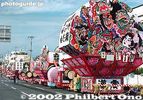
There are three types of floats: the large fan-shaped Neputa, Nebuta-type figures, and the children's small Neputa.I got to Hirosaki early enough before the parade to see the floats lined up at the starting point. Hirosaki is a 30-min. train ride from Aomori, and best known for Hirosaki Castle during cherry blossom season.
|
|

Welcome sign at Nagano Station
|
|

Pulling the float, Narita Gion Matsuri
|
|

There are five rows of streamers. In Japan, the koi carp is regarded as a symbol of valiant manhood because it swims up the river against the rapids.
|
|
|

"Blue Ocean Waves" (青海波)They performed four numbers. This first one was called "Blue Ocean Waves" performed by five geisha.
|
|
|
|
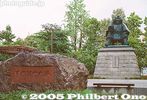
Park in front of Kofu Station.
|
|
|

Built in 1936.
|
|
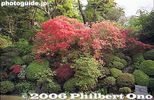
Garden (photos taken in early May)
|
|
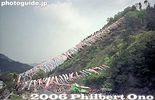
Eight strings of carp streamers hover over the river.
|
|
|
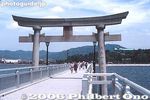
Torii on Takeshima island
|
|
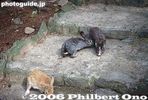
Rabbits
|
|
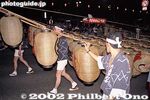
A kanto is carried into the street to the sound of flutes and taiko drums.
|
|
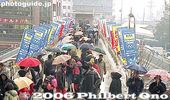
Nagano Station, East Exit to Olympic PlazaAt the East Exit of Nagano Station, this bridge, lined with advertising banners, led the way to the Olympic Plaza which featured ten tent pavilions made by official sponsors.
|
|

Crowds already line Tokushima's main street soon to be closed to traffic.
|
|
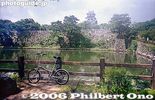
My bicycle
|
|
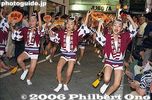
The troupe can consist of children (as young as age 2 or 3), women, and men.The Awa Odori originated 400 years ago in Tokushima Prefecture (in Shikoku) where it is one of Japan's most famous festivals. Although it is not as large as the one in Tokushima, the Koenji Awa Odori in Tokyo has become a major summer festival in Tokyo.
|
|
|

Path to Chiba Castle (visible on left)
|
|
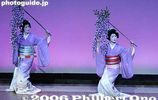
1. Fuji Murasaki (Purple Wisteria)
|
|

Shinmaru Park 新丸広場
|
|

Kasumigaike Pond and the famous Kotoji-toro stone lantern. The lantern is shaped like a bridge that supports a string on the koto instrument. 霞ヶ池 徽軫灯籠
|
|

Temple gate and flag
|
|

Norijiri horseman leads the procession. 乗尻The procession, called Roto-no-Gi (路頭の儀), is actually one of three rites performed during the festival.
|
|
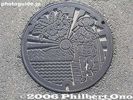
Manhole with the symbol of Hino merchant, Shiga Prefecture
|
|

Torii at Umamioka Watamuki Shrine in Hino, Shiga Pref.
|
|

Path to Nakano Castle ruins
|
|
|
|

Pontocho is a narrow alley and known as a geisha district.
|
|

Carrying back a single sculling boat
|
|

Promenade to the shrine
|
|

Pre-festival event held in the afternoon, Yamato Awa Odori
|
|

Gosha Shrine torii
|
|

Corridor to anime fair
|
|

Pumping (or humping) the...
|
|
|
|

Huge trees shower you with cherry blossoms.
|
|

Visitors Center entrance courtyard
|
|

Crowd enters the Kokugikan for Musashimaru's retirement ceremony on Oct. 2, 2004.
|
|

Looks like Suganuma, another village in Gokayama area.
|
|

Chiba Park approach
|
|

Children lead the way for a float at Kawagoe Festival.
|
|
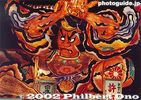
According to one story, the Nebuta has its roots in the 8th century.According to one story, the Nebuta has its roots in the 8th century when there was a rebellion in Ezo (Hokkaido). Ordered by Emperor Kanmu to quell the rebellion, generalissmo Sakanoue no Tamuramaro went to Ezo. However, he failed to capture the elusive chief of Ezo who went into hiding in the mountains.
Sakanoue then set up a trap with large votive lanterns which were lit and accompanied by taiko drums and flutes. This lured the curious Ezo chief out of hiding and led to his capture. The large lanterns were the forerunner of the Nebuta.
|
|

Lunch break
|
|

Tired from walking, Narita Gion Matsuri
|
|

The cable length is 250 meters and 13mmm thick. There are about 1,200 carp streamers. They are reused every year and donated by local families. (I also noticed a few advertising carps.)
|
|
|

Yokozuna Deliberation Council membersIn the middle is Kitanoumi.
|
|

Statue of Takeda Shingen.
|
|
|

Lead float with Edo festival music played by children. The names of the children playing are written on the red lanterns hanging above. Kodomo Edo-bayashi yatai 先導 子供江戸囃子屋台
|
|

Made of concrete.
|
|
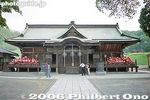
Shorinzan Daruma Temple 少林山達磨寺Daruma offerings on both sides of the temple.
|
|
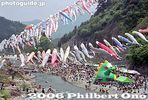
These pictures were taken in May 2003, when Kanna-machi town was newly formed upon the merging of Manba town and Nakazato village.
|
|

Shinkyo Sacred Bridge, Nikko 神橋
|
|
|
|
|
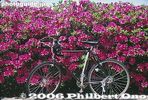
My bicycle somewhere in Gamagori.
|
|

Feeding a rabbit
|
|
|
|
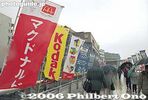
To Olympic Plaza
|
|

These photos were taken in Aug. 1999.
|
|

The Koenji Awa Odori has become a major summer festival in Tokyo. It had a humble beginning in 1957 when it was originally called the Koenji Baka Odori. "Baka" means fool.
|
|
|
|

Chiba Castle and paper lanterns
|
|

1. Fuji Murasaki (Purple Wisteria)
|
|

Dobashi-mon Gate stone walls 土橋門石垣
|
|

Famous Kotoji-toro stone lantern 徽軫灯籠
|
|

Play room for kids on Hanamatsuri
|
|

10:30 am: Starting point at Kyoto Gosho Imperial Palace 京都御所 出発The procession is ready to depart.
|
|

Omi Hino Merchant House. The former home of Hino merchant Yamanaka Hyouemon was donated to the town in 1981. Now a museum exhibiting the history and artifacts of the Hino merchants. 近江日野商人館Small admission charged. Open 9 am to 4 pm, closed on Mon. and Fri. Close to the center of town.
Address: Okubo 1011, Hino-cho
Phone No.: 0748-52-0007
山中兵右衛門
|
|
|
|

Dance program for 2005.
|
|
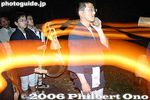
The torch procession rings out.
|
|

Kakegawa, Shizuoka
|
|

Spotlights create a silhouette of the statue of Omura Masujiro (1824-1869) 大村益次郎, founder of Japan's modern army.
|
|
|

Statue of castle founder and 1st lord, Yuki Hideyasu 結城秀康
|
|
|

Plum Blossom Queen at Kairakuen StationShe was passing out maps of the garden. It was a nice touch to see two of these kimono beauties greeting us.
|
|

PR poster
|
|

The festival is wildly popular with people from overseas.The shrine had various phallus props to pose with.
|
|

They keep going round and round. Quite rowdy.
|
|
|
|
|

Passing out programs
|
|
|

Pagoda at Kitain temple, Kawagoe
|
|
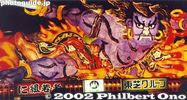
The first Nebuta was a large paper lantern made in 1593.According to historical records, the first Nebuta was a large paper lantern made in 1593 by Lord Tamenobu of Tsugaru (now part of Aomori) for the Bon festival in Kyoto. The Nebuta Festival itself started in the late 17th century.
|
|
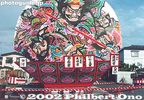
Fan-shaped Neputa float.The painted picture on the front of the Neputa depicts mostly warriors and on the back are beautiful courtesans.
|
|
|
|
|
|
|

Lowering the kite
|
|
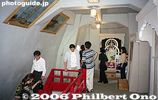
One of 20 Buddha figures inside the Kannon.During New Year's, many people visit the Kannon.
|
|

An Australian praying at the temple
|
|

I would say this is one of Japan's top five best places to see carp streamers at Kanna-machi, Gunma.
|
|
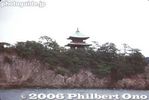
Bentenjima island near Tomonoura.
|
|
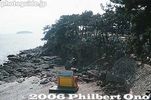
Rabbit Island
|
|

The largest kanto is 12 meters high, weighs 50 kilograms, and has 46 paper lanterns. The smaller kanto are 5 and 7 meters high. The kanto symbolizes a ripe rice plant with unhusked golden grains (the paper lanterns). The festival is therefore a prayer for a good harvest.
|
|
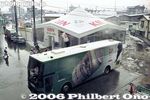
Pavilion by Kirin Brewery.Notice the "wrap" bus passing in front.
|
|

Pre-festival warm-up performance.
|
|
|
|

Imabari Castle 今治城
|
|

Highway in front of the castle.
|
|

Chiba Castle Sakura Matsuri lantern
|
|

1. Fuji Murasaki (Purple Wisteria)
|
|

Dobashi-mon Gate stone wall 土橋門石垣
|
|
|

Hanamatsuri altar
|
|

The strolling path is not a perfect circle, but you start and finish at the same point. The strolling path is lined with Japanese pines, flowering plants, maples, etc.
|
|

The procession basically consists of two columns: The Hon-retsu which includes the procession's highest-ranking official called Chokushi. It consists of men. The second and longer column is the Saio-dai-retsu consisting of women.
|
|
|

Nakano (Hino Castle) in Hino, Shiga Pref. The castle was built in 1534 by Lord Gamou Sadahide (1508-1579).
|
|

Barrels of sake next to the theater.
|
|

Towering inferno of bamboo on fire. The shrine has a 5-meter tall pile of bamboo which is lit to make a towering inferno within the shrine grounds. Very dramatic.
|
|

A bon dance around the base of the statue.
|
|

Stairs to Kakegawa Castle tower
|
|

Shimizu Bank
|
|

Haritsuna Shrine
|
|

Yamato Station
|
|

Entrance to Urakuen GardenThis garden has a few tea houses including one called Jo-an, a National Treasure. THe garden is close to Inuyama Castle and worth a visit. Admission 1,000 yen.
有楽苑
営業時間 9:00〜17:00(3/1〜7/14 ・ 9/1〜11/30)
9:00〜18:00(7/15〜8/31)
9:00〜16:00(12/1〜2/末日)
休日 無休 入場料 大人1,000円(呈茶別500円)
〒484−0081
愛知県犬山市御門先1
TEL 0568(61)4608
交通 名鉄犬山線犬山遊園下車徒歩7分
|
|
|
|

Plum Blossom Queen
|
|

The crowds
|
|

Dickhead hat. Actually, I don't know what they call it, but that's what I call it.
|
|

One trademark of the dancers is the crescent-shaped straw hats.
|
|
|
|

Shirakawa-go 白川郷
|
|
|
|

Wada House, Shirakawa-go
|
|

Musashimaru at the entrance
|
|

Entry road to Ainokura village. Bus stop shelter on right.
|
|

White weeping cherry blossoms
|
|

Toyama Castle
|
|

Preparation for building a Nebuta sculpture starts right after the preceding Nebuta Festival.Preparation for building a Nebuta sculpture starts right after the preceding Nebuta Festival. During fall and winter, Nebuta artists conceive the ideas for the next year's Nebuta floats. The Nebuta figures depict some scene from kabuki or Japanese/Chinese history or legend. Once a theme is chosen, a sketch or design is made and presented to the sponsor (usually a company). Upon approval, actual construction begins.
During February and March, the smaller parts of the Nebuta figure, such as the hands and fingers, are constructed at home with steel wiring.
In May, a tent village is put up. In each tent, full-scale construction of the Nebuta is executed until the end of June. Steel wiring and slender pieces of wood are used to build the frame and props.
After the skeleton of lumber and wire is completed, about 400 light bulbs and fluorescent lights are installed inside. The lights are strategically placed so that the shadow of the lumber pieces is not cast outward.
Then comes the tedious task of pasting washi paper on the wire frame. This is done by highly-skilled housewives who have been doing it for 10 to 20 years. About ten of them work on one Nebuta, taking about 10 days. Since they have to work dextrously in all sorts of contorted positions, it is not a popular job and fewer women are willing to do it.
The paper is cut to fit the exact segment (usually rectangular) on the wire frame. A toothbrush is used to apply glue on the wiring and the paper is pasted and cut. Extra care is taken when the figure's face is papered. About 2,500 sheets of 531 x 393 mm paper are consumed in the process.
|
|

The floats were jerked left and right and spun around.At 7:00 p.m., the taiko drum-beating started and the floats left the starting point one by one. The beat of the taiko drums was the same as that in the Nebuta Matsuri. A few men stood on the top of the large Neputa and collapsed the hinged, top portion to clear overhead power lines. The floats were jerked left and right and spun around.
|
|
|
|
|

Preparing unagi eel, Narita, Chiba. Also see the video at YouTube.Slicing it in half lengthwise.
|
|

Sumo elders in the front row
|
|
| 29169 files on 116 page(s) |
1 |
 |
 |
 |
 |
|